California Voluntary Guidance for Response to HABs in Recreational Inland Waters
Table of Contents
This voluntary guidance will assist responding organizations, including environmental and public health officials, land and waterbody managers, citizen scientists, and others in responding to inland harmful algal blooms (HABs) in California. Resources specific for PLANKTONIC (water column) HABs and BENTHIC MATS (which typically grow as mats along bottom substrate) are included below. For more information on BENTHIC MATS (also referred to as TOXIC ALGAL MATS for the general public) and how they differ from PLANKTONIC blooms within the water column, check out the FAQs on TOXIC ALGAL MATS page.
This guidance does not address cyanotoxins in drinking water; State Water Board’s Division of Drinking Water provides resources for addressing cyanotoxins in drinking water.
HAB Response Plan Summary and Key Resources
Table 1 below summarizes the current HAB Response Plan, the recommended actions, and key resources available on the California HAB Portal. This response plan can be adapted for a given incident, some steps may occur in a different order or simultaneously.
| Recommended Actions1 and Key Resources | |
|---|---|
Step 1: Surveillance and General Awareness |
Responding organizations (Water Boards, land/water manager, local health agency and/or collaborator) should visually inspect publicly accessible rivers, lakes, and reservoirs during recreation season for potential HABs, including those in the water column (PLANKTONIC) and mats attached to the bottom, floating, or stranded along the shore (BENTHIC MATS). Resources: |
Step 2: Initial Discovery and Reporting |
Reports of potential HAB occurrences and any potentially related human or animal illnesses should be made to the HAB Hotline (managed by Water Boards) by using any of the following:
Water Board staff will evaluate initial reports and post to the HAB portal incident map as appropriate. Resources: |
Step 3: Interagency Response Coordination and Communication |
As shown in Figure 1 below, Water Boards HAB coordinator coordinate with the reporting party and agency staff in responding to the HAB. Resources: |
Step 4: Field Screening |
Responding organization can use field screening methods for initial determination if cyanobacteria and cyanotoxins are present. As necessary, samples may be collected for lab analysis at this step (refer step 5). Resources: |
Step 5: Sampling for Lab Analysis |
Responding organization should collect water, scum, or algal mat samples for laboratory analysis consistent with the Field Guide. Contact HAB Hotline to coordinate potential field support and/or laboratory analysis. Refer to Field Guide SOP for sample storage (refrigerated) and short holding time (< 5 days). Resources: |
Step 6: Posting Advisory Sign |
If analyses or observations meet or exceed TRIGGER LEVELS for PLANKTONIC HABs or BENTHIC MATS, the responding organization should initiate coordination regarding sign posting by reporting to the HAB Hotline. Resources: |
Step 7: Continue Monitoring During an Advisory |
While under an advisory, water should be observed approximately bi-weekly by the responding organization. If observations suggest that the bloom or algal mats are significantly increasing or decreasing, then the responding organization should conduct follow-up monitoring for cyanotoxins and/or cyanobacteria 2. Resources: |
Step 8: De-posting and Routine Monitoring |
Once the visual indicators and/or cyanotoxin concentrations are below the de-posting criteria for PLANKTONIC HAB or BENTHIC MATS for minimum of two consecutive weeks, signage should be removed by the land and water management agency and/or local county coordinators. De-posting actions should be reported to the HAB Hotline. Public notification of de-posting by press and social media can be coordinated with the Water Boards, and outreach and communication tools are available. Resources: |
1Notification and communication is a key component of each step in the process.
2 While this guidance provides a response to current HABs, long-term plans are ultimately necessary to manage, mitigate, and prevent HABs. Contact the SWRCB’s Surface Ambient Monitoring Program (SWAMP), and check out the California Cyanobacterial and Harmful Algal Bloom (CCHAB) Network Mitigation Subcommittee’s Resources for Mitigating HABs page.
Interagency Response Coordination
Reports of HABs or potential HAB-related illnesses are received through the State Water Board’s reporting system. Once received, the report is investigated by the Interagency Task Force in a coordinated response with state and local representatives (see Figure 1 below) and displayed on the HAB incident report map.
HABs Response Contacts Table
Table 2 below provides contact information for staff at state agencies participating in the interagency task force.
Table 2. State Agency contacts for HAB response and the HAB-related illness workgroup
| Organization | Contact Information |
|---|---|
HAB Hotline, State Water Resources Control Board (State Board) |
|
|
Carly.Nilson@waterboards.ca.gov; |
|
|
|
View this map to select appropriate district office contact |
View the map on left to select appropriate region listed below (Regions 1-9) |
|
|
Michael.Thomas@waterboards.ca.gov; |
|
Kristina.Yoshida@waterboards.ca.gov |
|
|
|
|
|
|
|
Sabrina.Rice@waterboards.ca.gov |
|
|
|
|
|
Carey.Kowalski@waterboards.ca.gov |
Cal EPA, Office of Environmental Health Hazard and Assessment |
habs@oehha.ca.gov (general info); |
Tracking California / California Department of Public Health |
|
| California Department of Fish and Wildlife, Statewide HAB Coordinator | Karen.Odkins@Wildlife.ca.gov (primary contact) |
| California Department of Fish and Wildlife, Wildlife Health Laboratory | WILab@wildlife.ca.gov (*general info); |
* Note that the WIL email will likely change to WHL at some point
Advisory Signs and Posting Guidance for Planktonic HABs
Participating state agencies - State Water Resources Control Board, Office of Environmental Health Hazard and Assessment (OEHHA), and California Department of Public Health (CDPH) - developed these guidelines for PLANKTONIC (water column) blooms. The California Cyanobacteria and Harmful Algal Bloom Network (CCHAB) under the California Water Quality Monitoring Council adopted them as voluntary guidance (not policy or regulation) in 2016, and recommends their use to promote consistency in public notification and risk communication throughout California. A frequently asked questions (FAQs) on HAB signs is available for the general public.
Planktonic HAB Posting Guidance
These trigger levels and decision tree for posting PLANKTONIC advisory signs (Caution, Warning, and Danger) were developed to protect human and animal (dogs and livestock) health from HABs. The trigger levels are based on the following criteria: concentrations of three major cyanotoxins in water, cell count of potential toxin producers, and site specific indicators. For more information on how these levels were derived, refer to Appendix A - Description of cyanotoxin trigger levels in recreational water bodies.
- Trigger Levels and Response Decision Tree for Planktonic Blooms
- Appendix A - Description of cyanotoxin trigger levels in recreational water bodies (PDF)
Table 3. CCHAB trigger levels for posting PLANKTONIC advisory signs.
| Trigger Levels For Human and Animal Health | ||||
|---|---|---|---|---|
| Criteria* | No Advisory a | Caution (TIER 1) |
Warning (TIER 2) |
Danger (TIER 3) |
Total Microcystins b |
< 0.8 µg/L |
0.8 µg/L |
6 µg/L |
20 µg/L |
Anatoxin-a |
Non-detect c |
Detected c |
20 µg/L |
90 µg/L |
Cylindrospermopsin |
< 1 µg/L |
1 µg/L |
4 µg/L |
17 µg/L |
Cell Density of potential toxin producers |
< 4,000 cells/mL |
4,000 cells/mL |
______ |
______ |
Site-specific indicator(s) |
No site-specific indicators present |
Discoloration, scum, algal mats, soupy or paint-like appearance. |
______ |
______ |
* Action levels are met when one or more criteria are met.
a For de-posting, all criteria for no advisory must be met for a minimum of 2 weeks. General awareness sign may remain posted and healthy water habits are still recommended.
b Microcystins refers to the sum of all measured Microcystin congeners.
c Must use an analytical method that detects ≤ 1μg/L Anatoxin-a.

Figure 2. Response Decision Tree for Planktonic Blooms
Planktonic HAB Advisory Signs
The Planktonic HAB advisory signs are available in both English and Spanish, either as an individual signs in a single language or as a combination with both languages on one sign.
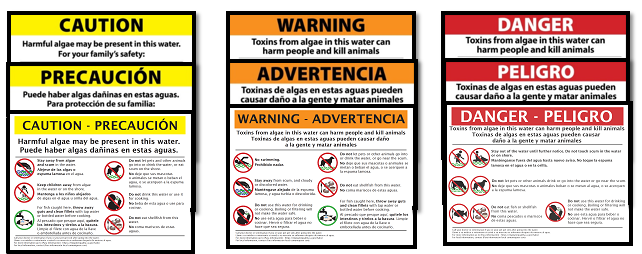
- The PDF format provides pre-made planktonic HAB advisory signs and space to insert local agency contact information. The English, Spanish, and English/Spanish combination versions of all three signs (Caution, Warning, Danger) in PDF format are combined into a single file.
- The PowerPoint format allows customization of signs by deleting individual icon/text message components that are not appropriate for a specific water body, such as messaging specific to an activity that is not otherwise permitted. However, text with each component cannot be changed. Components can be moved to allow more space for local agency contact information (text box at the bottom of each sign). The English and Spanish versions of all three signs (Caution, Warning, Danger) in PowerPoint format are combined into a single file.
- The individual signs and icons (in PowerPoint format) are also available as supplemental information.
Planktonic General Awareness HAB Signs
The PLANKTONIC general awareness HAB signs below are two templates provided by the US EPA that have been customized for for California.
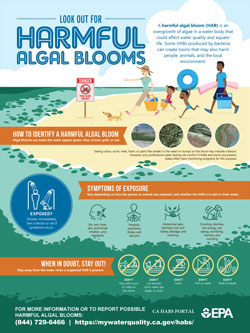
- Abbreviated infographic (PDF)
- Detailed infographic (PDF)
- General awareness signs or infographics can be used to inform the public of the potential for PLANKTONIC HABs, how to identify them, potential symptoms, healthy water habits, and where to find additional resources.
- These signs can be posted permanently at waterbodies where PLANKTONIC HABs may occur and used in combination with advisory signs triggered by specific visual observations or water column cyanotoxin results as described above.
- These signs are not intended to replace advisory signs or preclude water testing for cyanotoxins.
Benthic Cyanobacteria (Toxic Algal Mats) Signs and Posting Guidelines
The CCHAB Network Benthic Signage Subcommittee developed signs (general awareness and BENTHIC trigger level) and posting guidelines for BENTHIC MATS, also referred to as TOXIC ALGAL MATS. These resources were reviewed and adopted for use by CCHAB Network in 2020.
- Full description of the benthic algal mat signs and advisories
- FAQs on Toxic Algal Mats
- Posting Guidelines for Benthic Mats Signs
- General Awareness Sign
- Benthic Trigger Level Sign
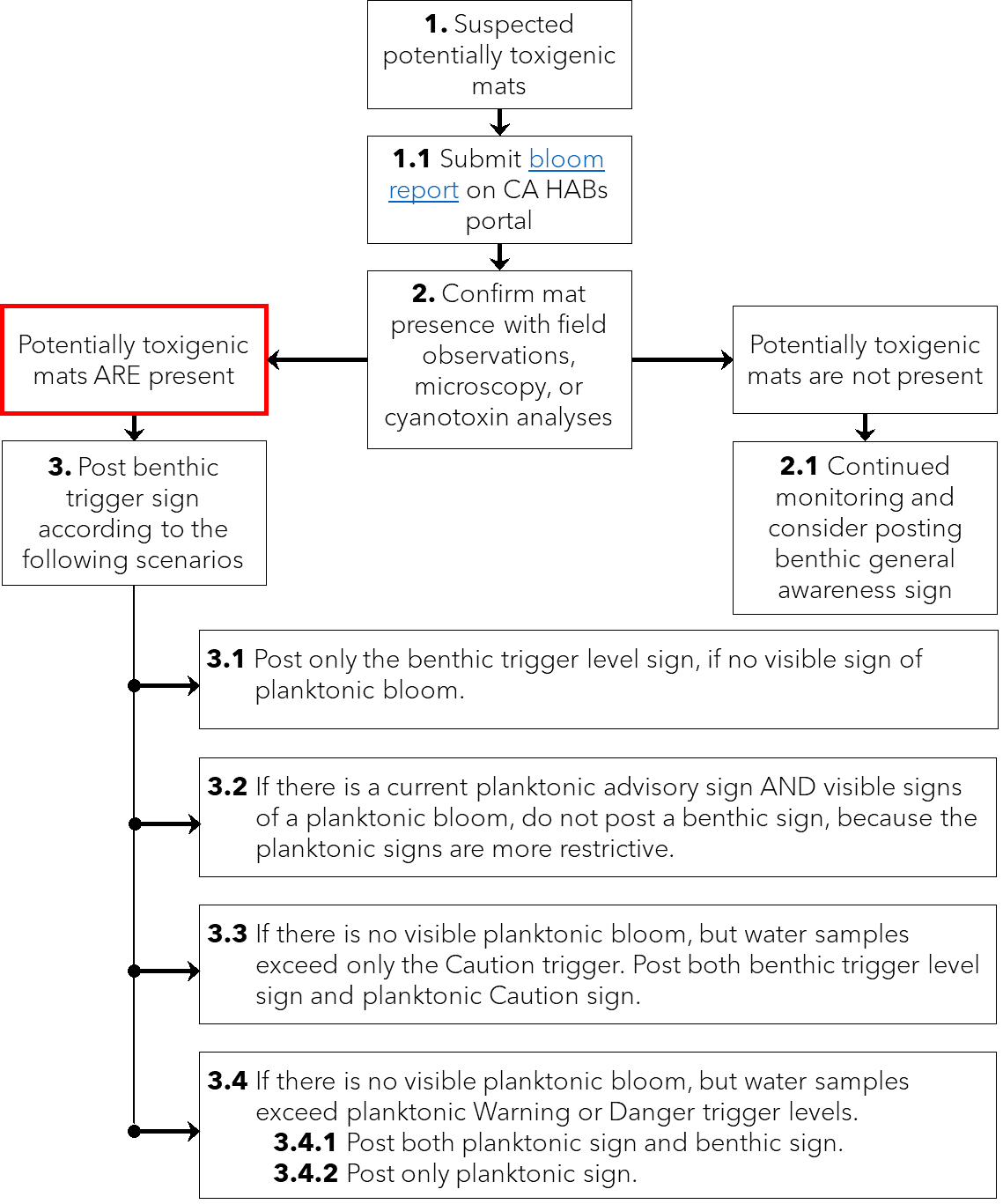
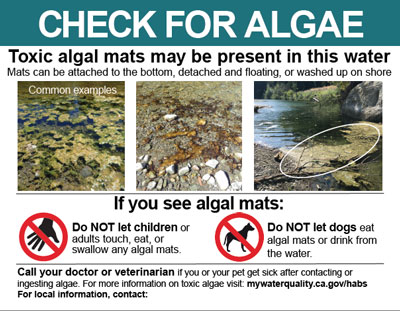
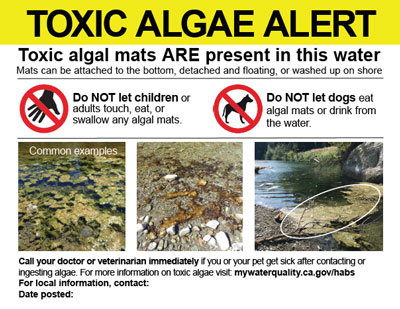
HAB Outreach and Communication
In addition to signage, other forms of outreach and communication may be appropriate, both during a current incident and to increase awareness of potential HABs and their potential health impacts. Resources available on the CA HABs Portal are summarized below. US EPA also provides general HAB communication tools.
Public notifications and press communications for a current HAB incident
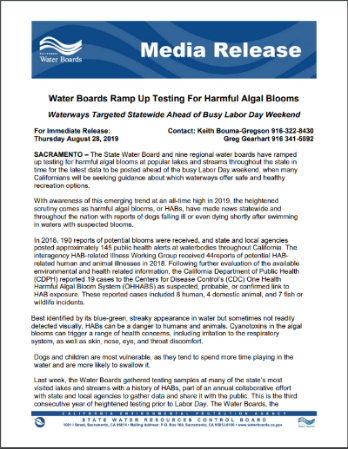
- State Water Resources Control Board can assist with notifications and press communications, and has developed templates (including press and social media templates and talking points) available upon request. For details contact the HAB Hotline at CyanoHAB.Reports@waterboards.ca.gov or 844-729-6466 (toll free).
- Protocol for Publicizing Harmful Algal Blooms (HABs) in State Waterbodies (06/25/2018).
Resources for use with the general public
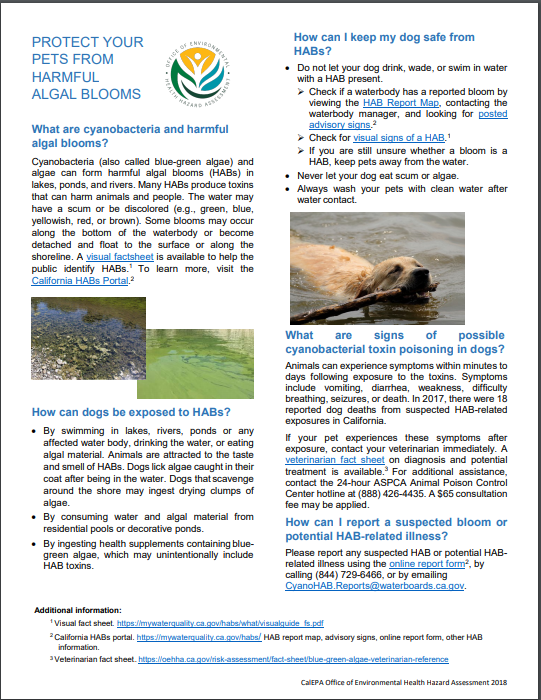
- Frequently Asked Questions (FAQs) on Freshwater and Estuarine Harmful Algal Blooms
- FAQs on Human Health
- FAQs on Dogs and Dog Owner factsheet
- FAQs on Livestock and other Large Animals
- FAQs on Fish
- FAQs on Wildlife (Wild Birds and Mammals)
- HAB-Related Illness Tracking factsheet and webpage
- FAQs on HAB signs
- FAQs on toxic algal mats
- FAQs on HABs in Drinking water
Resources for use with medical professionals and veterinarians
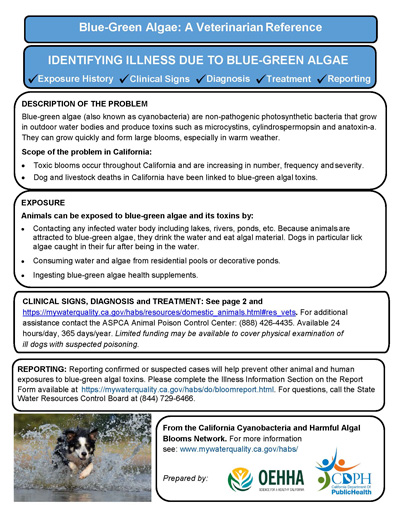
- Doctors and veterinarians may not be familiar with the symptoms of cyanotoxin exposure, potential treatment, and how to report potential HAB-related illnesses in humans, pets, and livestock.
- The online pages linked above include resources that can be shared with local medical providers and veterinarians to assist in appropriate diagnosis, treatment, and reporting, and to share with their clients.
- The HAB-related Illness Tracking webpage summarizes previously reported human and animal illnesses related to HABs in California.





